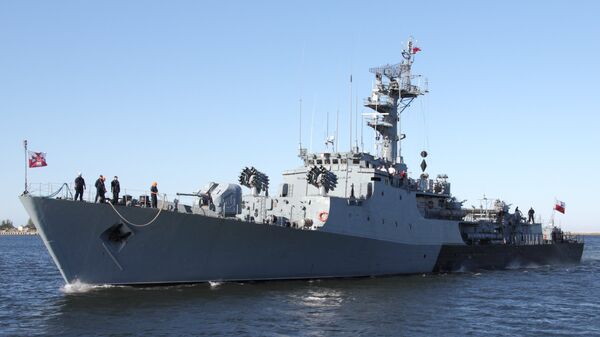On Friday, the National Security Bureau, the BBN, published its recommendations for the development of Poland's Navy, saying that it must have a modern fleet with at least limited global power projection capabilities, including the ability to operate at great distances from its territorial waters, in cooperation and coordination with larger NATO fleets.
The BBN concept envisions the purchase of multipurpose frigates with modern air defense capabilities, and proposes changing the fleet's structure and its greater use in allied operations. "Only in this way will Poland be able to neutralize potential threats, including those emanating from Russia, and to demonstrate its solidarity with allies," the BBN report says.
Another threat from Moscow, according to the BBN, is Russia's "monopolistic position" in the area of energy supplies, including the Russian energy transport infrastructure network.
The framework presents a scenario on a possible full-scale conflict with Russia in the Baltic region. "In a conflict situation, due her geographical disadvantage in the Baltic Sea, Russia will try to use air attacks to impact NATO countries, as well as Sweden and Finland, without the need to immediately use the Navy or conduct amphibious operations," the report says.
Finally, BBN's recommendations say that in case of conflict, a crucial role would fall on the exits from Russian ports in the northeastern Baltic Sea. Accordingly, the report recommends the use of Polish, NATO, Finnish and Swedish ships to blockade Russian ports, pending a significant upgrade to the Polish Navy's capabilities. "In the event of cooperation with NATO forces, or at least those of Finland and Sweden, these exits could be easily blocked by the Polish Navy, in cooperation with the air forces capable of destroying ships," the report notes.
Asked to comment on the report, respected Russian military expert Igor Korotchenko, editor in chief of National Defense magazine, said that the BBN's report "is based on a false premise of Russia being one of the main threats for Warsaw to take into account."
"On the basis of this false premise, the possibility of a military conflict with Russia – factually a full-scale war, is analyzed, and from here the recommendations looking to 'pump up the Polish Navy's muscles' are made," the analyst added.
The real motives behind the report can be found in its pages, Korotchenko said, and include Warsaw's desire to have more 'leverage' over Moscow on Russia's Baltic Sea natural gas pipelines.
Admiral Vladimir Baluyev, who served as commander of the Russian Baltic Fleet from 2001 to 2006, told RIA Novosti that at current funding, the Polish Navy will not be able to fulfill the BNN's recommendations on naval superiority in the Baltic even decades from now.
In 1946, the officer recalled, the Soviet Union transferred two dozen ships to the fledging Polish Navy, including nine minesweepers, 12 subchasers, two torpedo boats and two submarines. From 1955 to 1991, Poland was a member of the Soviet-led Warsaw Pact, and joined NATO in 1999.
Today, Baluyev noted, "the Polish Navy is one the most 'mature' navies in the world, to put it kindly. As of 2012, it had 41 warships, including five submarines, two frigates, and a corvette. Among its subs, including one Soviet one and four Swedish vessels, the newest among them was forty years old."
"In other words," the officer added, "its submarines are listed as being in active service only on paper."
But for these plans to be realized, Warsaw will need to invest up to $10 billion over the next decade. Accordingly, Baluyev suggested that the likelihood of the program actually being adopted is very low, "especially given that the Poles still haven't paid off the Americans for their F-16 fighters."
As for the BNN's plans, Baluyev noted that "the decisions which are adopted [at the political level] exceed Poland's actual economic and fiscal capabilities. Even a stripped-down version of the Polish shipbuilding program up to 2030 would be difficult to achieve due to its high costs. Poland may be caught with their pants down [in terms of defense capabilities], for which Poles will want to nail their legislative and executive authorities to the wall."
The admiral pointed out that when taking into account the fact that the construction of the average warship takes about five years, and given the age of the current fleet, the Polish Navy may find itself unable to fulfill its assigned tasks after 2018.
Therefore, in a situation where even the existing shipbuilding program will take many decades to implement, calling for enhanced power projection capabilities and writing up exciting new programs on how the Polish Navy can achieve total naval, air, and underwater superiority in the Baltic seem like little more than a fanciful waste of time.






